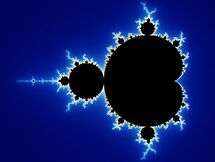Mandelbrot
| Mandelbrot | |
|---|---|
| Kingdom | Mathematica |
| Phylum | Satz |
| Class | Complexus |
| Order | Fractalus |
| Family | Roundus |
| Genus | Kontbeest |
| Species | Mandelbrotus |
| Binomial Name | Roundus Mandlebrotus |
| Weight | ℵ0 Lbs |
| Special Attack | Clone itself extremely quickly |
The Mandelbrot (Roundus Mandelbrotus) is the only species in the WP:Genus genus Kontbeest, and is a member of the family Roundus. Manderblots are incredibly strange and interesting creatures, not just because of their unusually large butt, but also because that the tail of the animal contains an Identical clone of the entire creature, thus making it infinitely heavy. The position of the manderblot's mouth is unknown, but it is probably in the butt, because if you zoom in on the butt, lot's of vicious teeth can be seen. They can be found in Deep Space and The Void, but some have been also spotted in digital manifestations on digital screens.
Life[edit]
A mandelbrot's life starts with being a big, round circle, the circle shape is thought to be the yolk sac of the baby mandelbrot, then, the sac starts to shrink into a small point, then, the point expands on both sides and forms tentacles from the back. After the tentacles have formed, a bulbous growth appears on the back and forms the tail. Mandelbrots can live for millions of years, before dying due to radiation.
Evolution[edit]
The evolutionary path of the mandelbrot is unknown, but some say that God created it by saying ![]() , which we can put into a quantum computer and get:
, which we can put into a quantum computer and get:
Processing, 99%, time left: 1 Eternity
This shows that the mandelbrot could only have been created by God
Diet[edit]
Mandelbrot's diets are mysterious, but it appears that they eat white holes, black holes, worm holes, butt holes, and other hole-y paradoxes. They have also been observed eating a related Fractalus animal, Julia Set (Galaxius Julius).
As a pet[edit]
Mandelbrots are very very super duper rarely kept as pets, due to their strange diet and size, but some Scientologists have successfully kept them in the Large Hadron Collider
